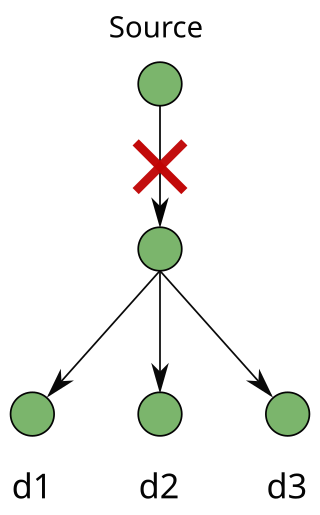
In fiber-optic communication, a single-mode optical fiber (SMF), also known as fundamental- or mono-mode, is an optical fiber designed to carry only a single mode of light - the transverse mode. Modes are the possible solutions of the Helmholtz equation for waves, which is obtained by combining Maxwell's equations and the boundary conditions. These modes define the way the wave travels through space, i.e. how the wave is distributed in space. Waves can have the same mode but have different frequencies. This is the case in single-mode fibers, where we can have waves with different frequencies, but of the same mode, which means that they are distributed in space in the same way, and that gives us a single ray of light. Although the ray travels parallel to the length of the fiber, it is often called transverse mode since its electromagnetic oscillations occur perpendicular (transverse) to the length of the fiber. The 2009 Nobel Prize in Physics was awarded to Charles K. Kao for his theoretical work on the single-mode optical fiber. The standards G.652 and G.657 define the most widely used forms of single-mode optical fiber.

In fiber-optic communications, wavelength-division multiplexing (WDM) is a technology which multiplexes a number of optical carrier signals onto a single optical fiber by using different wavelengths of laser light. This technique enables bidirectional communications over a single strand of fiber as well as multiplication of capacity.
Optical burst switching (OBS) is an optical networking technique that allows dynamic sub-wavelength switching of data. OBS is viewed as a compromise between the yet unfeasible full optical packet switching (OPS) and the mostly static optical circuit switching (OCS). It differs from these paradigms because OBS control information is sent separately in a reserved optical channel and in advance of the data payload. These control signals can then be processed electronically to allow the timely setup of an optical light path to transport the soon-to-arrive payload. This is known as delayed reservation.

A passive optical network (PON) is a fiber-optic telecommunications network that uses only unpowered devices to carry signals, as opposed to electronic equipment. In practice, PONs are typically used for the last mile between Internet service providers (ISP) and their customers. In this use, a PON has a point-to-multipoint topology in which an ISP uses a single device to serve many end-user sites using a system such as 10G-PON or GPON. In this one-to-many topology, a single fiber serving many sites branches into multiple fibers through a passive splitter, and those fibers can each serve multiple sites through further splitters. The light from the ISP is divided through the splitters to reach all the customer sites, and light from the customer sites is combined into the single fiber. Many fiber ISPs prefer this system.
The routing and wavelength assignment (RWA) problem is an optical networking problem with the goal of maximizing the number of optical connections.
Automatically Switched Optical Network (ASON) is a concept for the evolution of transport networks which allows for dynamic policy-driven control of an optical or SDH network based on signaling between a user and components of the network. Its aim is to automate the resource and connection management within the network. The IETF defines ASON as an alternative/supplement to NMS based connection management.
Automatic Switched Transport Network (ASTN) allows traffic paths to be set up through a switched network automatically. The term ASTN replaces the term ASON and is often used interchangeably with GMPLS. This is not completely correct as GMPLS is a family of protocols, but ASON/ASTN is an optical/transport network architecture. The requirements of the ASON/ASTN architecture can be satisfied using GMPLS protocols developed by the IETF or by GMPLS protocols that have been modified by the ITU. Furthermore, the GMPLS protocols are applicable to optical and non-optical networks, and can be used in transport or client networks. Thus, GMPLS is a wider concept than ASTN.

IEEE Standard 1355-1995, IEC 14575, or ISO 14575 is a data communications standard for Heterogeneous Interconnect (HIC).
Optical networking is a means of communication that uses signals encoded in light to transmit information in various types of telecommunications networks. These include limited range local-area networks (LAN) or wide area networks (WANs), which cross metropolitan and regional areas as well as long-distance national, international and transoceanic networks. It is a form of optical communication that relies on optical amplifiers, lasers or LEDs and wavelength-division multiplexing (WDM) to transmit large quantities of data, generally across fiber-optic cables. Because it is capable of achieving extremely high bandwidth, it is an enabling technology for the Internet and telecommunication networks that transmit the vast majority of all human and machine-to-machine information.
An optical cross-connect (OXC) is a device used by telecommunications carriers to switch high-speed optical signals in a fiber optic network, such as an optical mesh network.

An optical add-drop multiplexer (OADM) is a device used in wavelength-division multiplexing (WDM) systems for multiplexing and routing different channels of light into or out of a single-mode fiber (SMF). This is a type of optical node, which is generally used for the formation and the construction of optical telecommunications networks. "Add" and "drop" here refer to the capability of the device to add one or more new wavelength channels to an existing multi-wavelength WDM signal, and/or to drop (remove) one or more channels, passing those signals to another network path. An OADM may be considered to be a specific type of optical cross-connect.

Fiber-optic communication is a method of transmitting information from one place to another by sending pulses of infrared or visible light through an optical fiber. The light is a form of carrier wave that is modulated to carry information. Fiber is preferred over electrical cabling when high bandwidth, long distance, or immunity to electromagnetic interference is required. This type of communication can transmit voice, video, and telemetry through local area networks or across long distances.

An optical mesh network is a type of optical telecommunications network employing wired fiber-optic communication or wireless free-space optical communication in a mesh network architecture.
Generalized Multi-Protocol Label Switching (GMPLS) is a protocol suite extending MPLS to manage further classes of interfaces and switching technologies other than packet interfaces and switching, such as time-division multiplexing, layer-2 switching, wavelength switching and fiber-switching.
Admission control is a validation process in communication systems where a check is performed before a connection is established to see if current resources are sufficient for the proposed connection.

A multicast session requires a "point-to-multipoint" connection from a source node to multiple destination nodes. The source node is known as the root. The destination nodes are known as leaves. In the modern era, it is important to protect multicast connections in an optical mesh network. Recently, multicast applications have gained popularity as they are important to protecting critical sessions against failures such as fiber cuts, hardware faults, and natural disasters.
Link protection is designed to safeguard networks from failure. Failures in high-speed networks have always been a concern of utmost importance. A single fiber cut can lead to heavy losses of traffic and protection-switching techniques have been used as the key source to ensure survivability in networks. Survivability can be addressed in many layers in a network and protection can be performed at the physical layer, Layer 2 and Layer 3 (IP).
In optical networking, a lightpath is a path between two nodes in an optical network between which light passes through unmodified.
Jason P Jue is a professor of computer science and the director of the Advanced Networks Research Lab at the University of Texas at Dallas.
George N. Rouskas is a computer scientist, academic, and author. He is an Alumni Distinguished Graduate Professor and Director of Graduate Programs in the Department of Computer Science at North Carolina State University.








